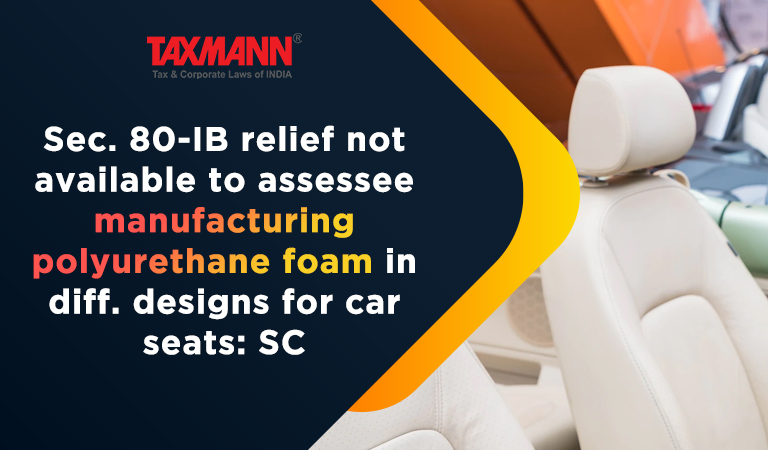Sec. 80-IB relief not available to assessee manufacturing polyurethane foam in diff. designs for car seats: SC
- Blog|News|Income Tax|
- 2 Min Read
- By Taxmann
- |
- Last Updated on 22 November, 2022

Case Details: Polyflex (India) (P.) Ltd. v. CIT - [2022] 145 taxmann.com 44 (SC)
Judiciary and Counsel Details
-
- M.R. Shah & M.M. Sundresh, JJ.
Facts of the Case
The assessee was manufacturing ‘polyurethane foam,’ which was ultimately used as an automobile seat. The assessee filed the return of income claiming deduction under section 80-IB.
The Assessing Officer (AO) disallowed the deduction under Section 80-IB by observing that the nature of the business of the assessee was “manufacturer of polyurethane foam seats” which falls under entry 25 to the Eleventh Schedule. Hence, it was not entitled to claim deduction under Section 80-IB.
Supreme Court Held
The lower authorities upheld the order of AO. The matter reached the Supreme Court.
The Supreme Court of India upheld the findings of the High Court. The High Court had specifically observed and held that what was manufactured and sold by the assessee was polyurethane foam which was manufactured by injecting two chemicals, namely, Polyol and Isocyanate.
The assessee was manufacturing polyurethane foam and supplying the same in different sizes/designs to the assembly operator, which ultimately is being used for car seats. The assessee didn’t undertake any further process for the end product, namely, car seats.
Merely because the assessee was using the chemicals and ultimately what is manufactured is polyurethane foam and the same is used by assembly operators after the process of moulding as car seats, it cannot be said that the end product manufactured by the assessee is car seats/automobile seats.
There must be a further process to be undertaken by the assessee in manufacturing the car seats. No further process seems to have been undertaken by the assessee except supplying/selling the polyurethane foam in different sizes/designs/shapes which may be ultimately used for end products by others as car seats/automobile seats.
Therefore, when the articles/goods manufactured by the assessee, namely, polyurethane foam is an article classifiable in the Eleventh Schedule (entry 25), the assessee shall not be entitled to claim deduction under Section 80- IB(2)(iii).
Disclaimer: The content/information published on the website is only for general information of the user and shall not be construed as legal advice. While the Taxmann has exercised reasonable efforts to ensure the veracity of information/content published, Taxmann shall be under no liability in any manner whatsoever for incorrect information, if any.

Taxmann Publications has a dedicated in-house Research & Editorial Team. This team consists of a team of Chartered Accountants, Company Secretaries, and Lawyers. This team works under the guidance and supervision of editor-in-chief Mr Rakesh Bhargava.
The Research and Editorial Team is responsible for developing reliable and accurate content for the readers. The team follows the six-sigma approach to achieve the benchmark of zero error in its publications and research platforms. The team ensures that the following publication guidelines are thoroughly followed while developing the content:
- The statutory material is obtained only from the authorized and reliable sources
- All the latest developments in the judicial and legislative fields are covered
- Prepare the analytical write-ups on current, controversial, and important issues to help the readers to understand the concept and its implications
- Every content published by Taxmann is complete, accurate and lucid
- All evidence-based statements are supported with proper reference to Section, Circular No., Notification No. or citations
- The golden rules of grammar, style and consistency are thoroughly followed
- Font and size that’s easy to read and remain consistent across all imprint and digital publications are applied




